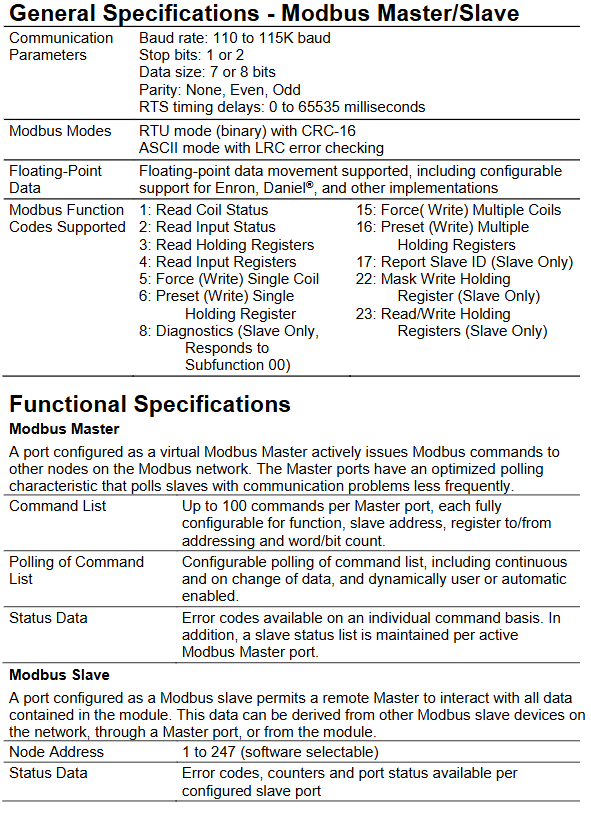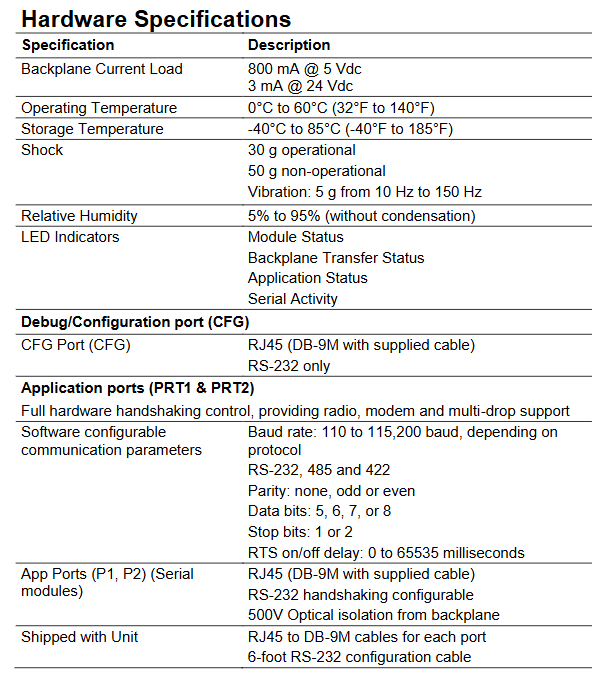

K-WANG


Rockwell ProSoft MVI56-MCM Modbus master-slave communication module
Rockwell ProSoft MVI56-MCM Modbus master-slave communication module
ProSoft MVI56-MCM is a product designed specifically for Rockwell Automation ® ControlLogix ® The Modbus master-slave communication module designed by the processor enables convenient integration between the ControlLogix system and other devices that support the Modbus protocol, such as PLCs, process control devices, and SCADA systems. As an interface module between the Modbus network and the ControlLogix backplane, it has high compatibility, ease of configuration, and reliable communication performance.
Core Features and Advantages
The module meets the flexible communication and efficient operation and maintenance needs in industrial scenarios through targeted design. The core features and corresponding values are as follows:
Characteristics classification, specific characteristics, advantages
Backboard technology authorized by Rockwell Automation; Support 1756 backplane single slot installation (local/remote rack) 1. Implement high-speed data transmission between modules and ControlLogix processors
2. Compatible with ControlLogix system architecture, no additional hardware adaptation required
The protocol supports Modbus RTU (binary, with CRC-16 checksum) and Modbus ASCII (with LRC error checksum) protocols; Support floating-point data transmission (including Enron and Daniel) ® 1. Adapt to the communication requirements of different Modbus devices, with wide compatibility
2. Meet the transmission requirements of high-precision data (such as flow and temperature) in industrial scenarios
Configuration and Monitoring 1. Based on RSLogix ™ 5000 configuration, supports viewing module data and status through controller tags
2. Provide example ladder diagrams with complete annotations (including user-defined data types, steps, and labels), which can be used in most scenarios without modification
3. LED diagnostic indicator lights (module status, backplane transmission status, application status, serial activity)
4. Menu driven hardware and protocol diagnostic tools; Support viewing module database content through serial port connection to PC 1. Reduce configuration threshold and shorten deployment time
2. Operations personnel can quickly locate faults (such as communication interruptions, module abnormalities), reducing downtime
20 years of experience in developing industrial communication solutions with technical support and warranty; Global free unlimited technical support (pre-sales, deployment, troubleshooting); 3-year warranty: 1. Ensure long-term stable operation of equipment and reduce maintenance risks
2. Global service network ensures timely access to support and adapts to cross-border project needs

Functional specifications
The module supports both Modbus master and slave modes, allowing for flexible configuration of port roles according to different communication topology requirements.
(1) Modbus master mode
After configuring the port as a master, it can actively send instructions to slave devices in the Modbus network, with intelligent polling and detailed status feedback capabilities:
Instruction configuration: Each master port supports up to 100 configurable instructions, each of which can customize function codes, slave addresses, register read/write addresses, and word/bit counts.
Polling strategy: supports flexible instruction list polling configuration, including continuous polling, polling when data changes, and can be manually or automatically enabled for polling; For slave stations with abnormal communication, the polling frequency will be automatically reduced to optimize network resource utilization.
Status feedback: Provide error codes for individual instructions and maintain a list of slave status for each active master port for troubleshooting purposes.
(2) Modbus Slave Mode
The port is configured to allow remote master access to all data within the module after the slave station (data can come from other Modbus slave stations in the network, master station ports, or the module itself):
Node address: Supports 1-247 software selectable addresses, suitable for multi device networking requirements.
Status monitoring: Each configured slave port provides error codes, counters, and port status data, providing real-time feedback on communication health.
(3) Supported Modbus Function Codes
Covering commonly used read and write operations in industrial scenarios to meet data collection and control requirements:
Function code function description applicable mode (master/slave)
1. Read the status of the coil from the master station (sending) and slave station (responding)
2. Read input status: master station (sending), slave station (responding)
3 Read and hold register master (send), slave (respond)
4. Read input register master (send), slave (respond)
5. Force (write) a single coil master station (send), slave station (respond)
6 preset (write) single hold register master (send), slave (respond)
8 Diagnosis (only supports sub function 00) Only slave station (response)
15. Force (write) multiple coil master stations (send) and slave stations (respond)
16 preset (write) multiple hold registers master (send), slave (respond)
Report 17: Slave ID Only Slave (Response)
22 Block Write Keep Register Only from Slave Station (Response)
23 Read Write Keep Register Only Slave (Response)
Hardware specifications and interfaces
(1) Basic hardware parameters
Detailed description of specification category
Backboard current consumption: 800mA at 5VDC; 3mA at 24Vdc
Working temperature: 0 ° C -60 ° C (32 ° F -140 ° F)
Storage temperature -40 ° C -85 ° C (-40 ° F -185 ° F)
Impact resistance performance working state: 30g; non working state: 50g
Anti vibration performance 5g at frequencies of 10Hz-150Hz
Relative humidity 5% -95% (non condensing)
LED indicator light module status light, backplane transmission status light, application status light, serial activity light
(2) Interface configuration
The module provides multiple dedicated interfaces to meet configuration, communication, and expansion requirements:
Configure/debug ports (CFG):
Interface type: RJ45 (including matching DB-9M adapter cable)
Communication standard: Only supports RS-232
Purpose: To connect to a PC for module configuration, diagnosis, and database viewing.
Application ports (PRT1&PRT2):
Interface type: RJ45 (including matching DB-9M adapter cable)
Communication standard: Supports RS-232/485/422, with full hardware handshake control (suitable for radio stations, modems, and multi machine networking scenarios)
Communication parameters: baud rate 110-115200 baud (depending on the protocol); Data bits 5/6/7/8; Stop position 1/2; Check bit none/odd/even; RTS switch delay 0-65535 milliseconds (software configurable).
(3) Accompanying accessories
RJ45 to DB-9M cable (1 per port)
6-foot RS-232 configuration cable

- YOKOGAWA
- Energy Access
- Renewable Integration
- Energy Subsidies
- Energy and Water
- Net zero emission
- Energy Security
- Critical Minerals
- A-B
- petroleum
- Mine scale
- Energy and Gender
- Covid-19
- man-machine
- Reliance
- ADVANCED
- SEW
- ProSoft
- WATLOW
- Kongsberg
- FANUC
- VSD
- DCS
- PLC
- Sewage treatment
- cement
- Yaskawa
- Woodward
- BOSCH Rexroth
- MOOG
- General Electric
- American NI
- Rolls-Royce
- CTI
- Honeywell
- EMERSON
- Automobile market
- xYCOM
- Motorola
- architecture
- Industrial information
- New energy
- electricity
- Construction site
- HIMA
- ABB
- Rockwell
- Schneider Modicon
- Siemens
- MAN
- GE
- TRICONEX
- Control Wave
- ALSTOM
- AMAT
- STUDER
- KONGSBERG
- MOTOROLA
- DANAHER MOTION
- Bentley
- Galil
- EATON
- MOLEX
- Triconex
- DEIF
- B&W
- ZYGO
- Aerotech
- DANFOSS
- KOLLMORGEN
- Beijer
- Endress+Hauser
- schneider
- Foxboro
- KB
- REXROTH
- YAMAHA
- Johnson
- Westinghouse
- WAGO
- TOSHIBA
- TEKTRONIX
-
Kollmorgen S33GNNA-RNNM-00 - Brushless Servo Motor
-
Kollmorgen 6sm56-s3000-g-s3-1325 - Servo Motor
-
Kollmorgen AKM52K-CCCN2-00 - Servo Motor
-
Kollmorgen PSR3-230/75-21-202 - Power Supply
-
Kollmorgen akm24d-anc2r-00 - Servo Motor
-
Kollmorgen AKM22E-ANCNR-00 - Servo Motor
-
Kollmorgen S60300-550 - Servo Drive
-
Kollmorgen B-204-B-21 - Servomotor
-
Kollmorgen AKM21E-BNBN1-00 - Servo Motor
-
Kollmorgen TT2953-1010-B - DC Servo Motor
-
Kollmorgen pa8500 - Servo Power Supply
-
Kollmorgen BDS4A-210J-0001-207C2 - Servo Drive
-
Kollmorgen TTRB1-4234-3064-AA - DC Servo Motor
-
Kollmorgen MH-827-A-43 - Servo Motor
-
Kollmorgen AKM24D-ACBNR-OO - Servo Motor
-
Kollmorgen 00-01207-002 - Servo Disk DC Motor
-
Kollmorgen AKM21C-ANBNAB-00 - Servo Motor
-
Kollmorgen PSR3-208/50-01-003 - Power Supply
-
Kollmorgen 6SM56-S3000 - Servo Motor
-
Kollmorgen DBL3H00130-B3M-000-S40 - Servo Motor
-
Kollmorgen 6SN37L-4000 - Servo Motor
-
Kollmorgen AKM65K-ACCNR-00 - Servo motor
-
Kollmorgen 6SM56-L3000-G - Servo Motor
-
Kollmorgen AKMH43H-CCCNRE5K - Servo Motor
-
Kollmorgen PSR4/52858300 - Power Supply
-
Kollmorgen KBM-79H03-E03 - Direct Drive Rotary Motor
-
Kollmorgen AKM33E-ANCNDA00 - Servo Motor
-
Kollmorgen U9M4/9FA4T/M23 - ServoDisc DC Motor
-
Kollmorgen AKM13C-ANCNR-00 - Servo Motor
-
Kollmorgen AKM43L-ACD2CA00 - Servo Motor
-
Kollmorgen AKM54K-CCCN2-00 - Servo Motor
-
Kollmorgen M-605-B-B1-B3 - Servo Motor
-
Kollmorgen AKD-P00606-NBAN-0000 - Rotary Drive
-
Kollmorgen 6SM-37M-6.000 - Servo Motor
-
Kollmorgen A.F.031.5 - Sercos Interface Board
-
Kollmorgen 918974 5054 - Servo PWM
-
Kollmorgen U12M4 - ServoDisc DC Motor
-
Kollmorgen AKD-B00606-NBAN-0000 - Servo Drive
-
Kollmorgen MV65WKS-CE310/22PB - Servo Drive
-
Kollmorgen 65WKS-CE310/22PB - Servo Drive
-
Kollmorgen EM10-27 - Module
-
Kollmorgen S64001 - Servo Drive
-
Kollmorgen CR03200-000000 - Servo Drive
-
Kollmorgen 6SM57M-3000+G - Servo Motor
-
Kollmorgen BDS4 - Servo Drive
-
Kollmorgen AKD-P00306-NBEC-000 - Servo Drive
-
Kollmorgen AKD-B01206-NBAN-0000 - Servo Drive
-
Kollmorgen STP-57D301 - Stepper Motor
-
Kollmorgen 6SM37L-4.000 - Servo Motor
-
Kollmorgen 44-10193-001 - Circuit Board
-
Kollmorgen PRDR9SP24SHA-12 - Board
-
Kollmorgen PRD-AMPE25EA-00 - Servo Drive
-
Kollmorgen DBL3N00130-0R2-000-S40 - Servo Motor
-
Kollmorgen S406BA-SE - Servo Drive
-
Kollmorgen AKD-P00607-NBEI-0000 - Servo Drive
-
Kollmorgen AKD-P01207-NBEC-0000 - Servo Drive
-
Kollmorgen CR03550 - Servo Drive
-
Kollmorgen VSA24-0012/1804J-20-042E - Servo Drive
-
Kollmorgen N2-AKM23D-B2C-10L-5B-4-MF1-FT1E-C0 - Actuator
-
Kollmorgen 04S-M60/12-PB - Servo Drive
-
Kollmorgen H33NLHP-LNW-NS50 - Stepper Motor
-
Kollmorgen A-78771 - Interlock Board
-
Kollmorgen AKM43E-SSSSS-06 - Servo Motor
-
Kollmorgen AKD-P00607-NBEC-0000 - Servo Drive
-
Kollmorgen E21NCHT-LNN-NS-00 - Stepper Motor
-
Kollmorgen cr10704 - Servo Drive
-
Kollmorgen d101a-93-1215-001 - Motor
-
Kollmorgen BDS4A-203J-0001-EB202B21P - Servo Drive
-
Kollmorgen MCSS23-6432-002 - Connector
-
Kollmorgen AKD-P01207-NACC-D065 - Servo Drive
-
Kollmorgen CK-S200-IP-AC-TB - I/O Adapter and Connector
-
Kollmorgen CR10260 - Servo Drive
-
Kollmorgen EC3-AKM42G-C2R-70-04A-200-MP2-FC2-C0 - Actuator
-
Kollmorgen BDS5A-206-01010-205B2-030 - Servo Drive
-
Kollmorgen s2350-vts - Servo Drive
-
Kollmorgen AKM24D-ANC2DB-00 - Servo Motor
-
Kollmorgen E31NCHT-LNN-NS-01 - Stepper Motor
-
Kollmorgen PRD-0051AMPF-Y0 - Servo Board
-
Kollmorgen TB03500 - Module
-
Kollmorgen 60WKS-M240/06-PB - Servo Drive
-
Kollmorgen M21NRXC-LNN-NS-00 - Stepper Motor
-
Kollmorgen H-344H-0212 - Servo Motor
-
Kollmorgen MCSS08-3232-001 - Connector
-
Kollmorgen AKM33H-ANCNC-00 - Servo Motor
-
Kollmorgen PA-2800 - Power Supply
-
Kollmorgen MTC308C1-R1C1 - Servo Motor
-
Kollmorgen PRDR0091300Z-00 - Capacitor Board
-
Kollmorgen BDS4A-206J-0024/01502D79 - Servo Drive
-
Kollmorgen S20330-VTS - Servo Drive
-
Kollmorgen S20250-CNS - Servo Drive
-
Kollmorgen SBD2-20-1105-WO - Servo Drive Board
-
Kollmorgen M405-C-A1--E1 - Servo Motor
-
Kollmorgen PRD-PB805EDD-00 - Servo Drive
-
Kollmorgen 6SM57S-3.000-J-09-HA-IN - Servo Motor
-
Kollmorgen AKM33H-ANCNDA-00 - Servo Motor
-
Kollmorgen PCB-00030200-04 - PCB
-
Kollmorgen H22SSLB-LNN-NS-02 - Stepper Motor
-
Kollmorgen BJRL-20012-110001 - Module
-
Kollmorgen BDS4A-206J-0001404A - Servo Drive
-
Kollmorgen H-342-H-0802 - Servo Motor
-
Kollmorgen CR10561 - Servo Drive
-
Kollmorgen BDS5A-206-00010-205B2-030 - Servo Drive
-
Kollmorgen BDS5A-206-00010-207B-2-030 - Servo Drive
-
Kollmorgen mcss08-3224-001 - Connector
-
Kollmorgen M-207-B-23-B3 - Servo Motor
-
Kollmorgen PRD-0041200Z-S0 - Encoder/Resolver Card
-
Kollmorgen MH-225-G-61 - Motor
-
Kollmorgen MT308B1-T1C1 - Servo Motor
-
Kollmorgen BDS4A-240J-0001604C83 - Servo Drive
-
Kollmorgen 6SM57-S-3000 - Servo Motor
-
Kollmorgen N-T31V-15-5B-6-MF3-FT1E-C251 - Actuator
-
Kollmorgen PRD-0051AMPA-X0 - Servo Board
-
Kollmorgen CF-SS-RHGE-09 - Cable
-
Kollmorgen DIGIFAS7204 - Servo Drive
-
Kollmorgen S30101-NA - Servo Drive
-
Kollmorgen DIGIFAS7201 - Servo Drive
-
Kollmorgen PRD-0051AMPA-Y0 - Servo Board
-
Kollmorgen AKM23D-EFCNC-00 - Servo Motor
-
Kollmorgen SE10000 - Servo Drive
-
Kollmorgen PSR4/5A-112-0400 - Power Supply
-
Kollmorgen AKM31H-ANCNC-01 - Servo Motor
-
Kollmorgen M-203-B-93-027 - Servo Motor
-
Kollmorgen CP-SS-G1HE-05 - Connector
-
Kollmorgen AKM42G-ASCNR-02 - Servo Motor
-
Kollmorgen DBL4N00750-B3M-000-S40 - Servo Motor
-
Kollmorgen R3-BK23-152B-12-PL-ASE-BS115 - Actuator
-
Kollmorgen MH-427-B-61 - Motor
-
Kollmorgen cr06902 - Servo Drive




